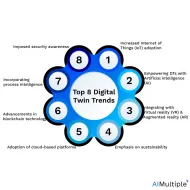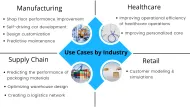Digital Twins

Discover Top 8 Digital Twin Trends in 2025
The digital twins market is estimated to grow 71% in two years. Business leaders and analysts must closely watch the competitive landscape and market requirements before investing in a digital twin tool. Explore top trends shaping the future of digital twins: 1.
Digital Twin Real Estate: 5 Leading Use Cases in 2025
Maintenance and utilities account for approximately 27 % of the operating expenses of a real estate firm. Digital twins can help real estate companies cut operating costs by up to 35%, while improving living standards and fostering sustainability.
![Top 5 Use Cases of Digital Twin in Automotive Industry ['25]](https://research.aimultiple.com/wp-content/uploads/2021/11/Digital-twin-in-automotive-1-190x107.png.webp)
Top 5 Use Cases of Digital Twin in Automotive Industry ['25]
The rise of Industry 4.0 and the growing adoption of big data are driving the demand for data-driven manufacturing strategies. Digital twin technology is a key concept, allowing businesses to simulate products for faster, cost-effective, and high-quality production. The automotive sector is estimated to have accounted for 15% of digital twin use cases last year.
3 Powerful Reasons to Use Digital Twin of an Organization
The global digital twin market size is estimated to reach $73.5 billion by 2027. Digital twin of an organization (DTO) is a newer application of digital twin technology, aiming to capture how a business functions in real time.

15 Digital Twin Applications/ Use Cases by Industry in 2025
As more sectors explore virtualization, digital twin solutions are gaining mainstream traction. According to Deloitte study, the global market for digital twins is expected to grow with 38% CAGR to reach $16 billion by 2023, and the proliferation of IoT technology accelerating this growth.